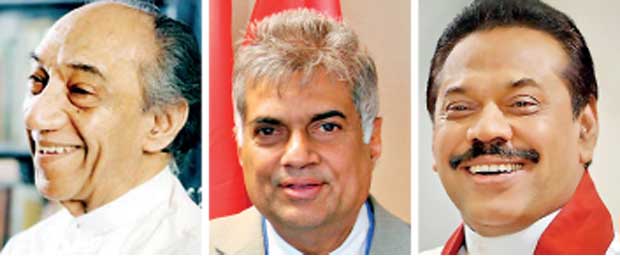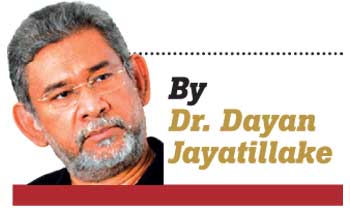THE RETURN TO CHINA AND THE GOVT’S CONSTITUTIONAL AGENDA
Posted on April 17th, 2016
By Dr. Dayan Jayatilleke
So economic reality dawned and the UNP leadership had to eat humble fortune cookie. China is back in the game in a major way, which is a good thing because it partially and temporarily stabilizes the economic crisis while re-balancing the island’s recently lopsided external relations. Ironically, the restored Chinese footprint may eventually be larger than it was under the Rajapaksa administration.
The China re-set was inevitable, and only proves the crass unrealism of the Yahapalana ideologues who went on an anti-Beijing binge. The Rajapaksas have been proven right in their strategic assessment that Sri Lanka’s destiny lay in Asia, and that China was Sri Lanka’s most indispensable and valuable friend. But they were wrong in putting all their eggs in the Beijing basket in the postwar second term.
Instead of a policy of multi-polar balancing a Lakshman Kadirgamar (and of course SWRD and Sirimavo Bandaranaike), the UNP-led Government has adopted a policy of multiple and multiplying dependence, lurching drunkenly in one direction and another. With its chronic political dysfunctions and developmental disability, it will beg, borrow and steal, and is parcelling off and selling as much of the country to as many buyers as it can beckon. It is external players rather than the Sri Lankan people and state who will be the biggest shareholders of the country and controllers of its destiny.
Post-Beijing, the Government is likely to overcompensate other external players who scramble to offset the Chinese return. An ethnically bipolar Sri Lanka with (I) its strategic Northern and Eastern border zone constitutionally converted into a mini-Tamil Nadu — a self-governing federal enclave and penetrable state let and (II) the ‘Hanuman Bridge’ which establishes contiguity with Tamil Nadu and encourages and enables irredentism, are likely give-aways.
Despite the fundamentally positive outcome of Premier Ranil Wickremesinghe’s retreat to China, his most basic thinking and agenda on the axial problem, the ethnic equation, are gravely erroneous. In the path-breaking volume ‘To End a Civil War’, Mark Salter discloses the sharply perceptive observation of the PM’s thinking by Norway’s top Foreign Affairs official engaged with Sri Lanka in 2001-2005:

… [Vidar] Helgesen came away with the impression that Premier Wickremesinghe’s basic agenda was to ‘let the Tamils have whatever is needed, short of independence’, so that the government could ‘get on with the business of making Sri Lanka the new Singapore’. Wickremesinghe’s essential agenda was to ‘get the economy going—liberalize, privatize’. And in this context, Eric Solheim recalls, the fact that both he [Wickremesinghe] and Helgessen were conservatives, ‘definitely helped’.” (p. 78)
This multiple revelation encapsulates everything that is amiss with PM Wickremesinghe’s thinking. Firstly the PM’s model is wrong. While Singapore is truly admirable as a society—it is the closest I  have seen to Plato’s Republic—its relevance to Sri Lanka is questionable. Singapore, like ancient Athens, is a city state. It has no rural hinterland. It has no peasants. It is utterly atypical for an Asian society and indeed for any society. It is not a complex country.
have seen to Plato’s Republic—its relevance to Sri Lanka is questionable. Singapore, like ancient Athens, is a city state. It has no rural hinterland. It has no peasants. It is utterly atypical for an Asian society and indeed for any society. It is not a complex country.
The PM’s second major error is in his formula for ‘getting the economy going’, namely to ‘privatize, liberalize’. President JR and his Finance Minister Ronnie de Mel brilliantly combined economic boldness with pragmatism, not only maintaining the State’s role in the economy but actually giving it the leading role in the flagship development project of the UNP government, the Accelerated Mahaweli Scheme. The ancillary yet major initiatives such as Premadasa’s Housing Programme, Gamani Dissanayake’s Swarnaboomi and Lalith Athulathmudali’s Mahapola were state-initiated, led or catalysed.
“This multiple revelation encapsulates everything that is amiss with PM Wickremesinghe’s thinking. Firstly the PM’s model is wrong. While Singapore is truly admirable as a society—it is the closest I have seen to Plato’s Republic—its relevance to Sri Lanka is questionable “
It is not accidental that Premier Wickremesinghe seeks to dismantle JR’s constitutional model of the executive Presidential system. As Eric Solheim correctly observed, Wickremesinghe’s doctrines stem from his adherence to the ideology of Conservatism. Hence his belief in economic neoliberalism i.e. liberalize, privatize” to get the economy working”. More specifically, his strong affiliation is with British Conservatism.
By contrast, JR belonged much more to the moderate, centrist Republicanism of the USA and  France– thus his Gaullist Presidential Constitution. In terms of political philosophy, the American and French Constitutions are infinitely more modern and progressive than the British parliamentary conservative tradition, which stood in opposition to the American and French political traditions. Indeed the American and French Republican political traditions arose as a critique of and rupture from the British Conservative parliamentarism that the Premier cleaves to.
France– thus his Gaullist Presidential Constitution. In terms of political philosophy, the American and French Constitutions are infinitely more modern and progressive than the British parliamentary conservative tradition, which stood in opposition to the American and French political traditions. Indeed the American and French Republican political traditions arose as a critique of and rupture from the British Conservative parliamentarism that the Premier cleaves to.
The Prime Minister’s doctrinal perspectives have clear economic repercussions. JR’s argument in favour of a presidential model was based on an economic rationale: the need for a strong and stable executive free from the whims and fancies of the legislature”.
In the triadic JR model, the open economic policy was fused with the unitary republic and the executive presidency. In his second term and even in retirement JR was opposed to going beyond the 13th Amendment (which he regarded as the maximum) and/or a return to the Westminster model.
“It is not accidental that Premier Wickremesinghe seeks to dismantle JR’s constitutional model of the executive Presidential system. As Eric Solheim correctly observed, Wickremesinghe’s doctrines stem from his adherence to the ideology of Conservatism”
This ensemble—and not simply an open economic policy– was the secret of the strong economic performance of Sri Lanka since 1978, through the war decades, and in the rapid postwar recovery. What Premier Wickremesinghe fails to understand is that JR’s open economic policy and his executive presidential system were inextricably linked; two modernizing sides of one developmental coin. You cannot have one without the other, or rather, if you try, as JR did as Finance Minister in 1952, you wind up with a popular upheaval and evacuation onto a waiting US ship.
As if this scenario was not sufficiently disquieting, we have the PM’s views on a new architecture for the State so as to resolve the ethno-national question. What is the root of the PM’s vision on ethnic and Constitutional reform which he will strive to actualize in a new Constitution? Salter’s book contains Eric Solheim’s revelation:
… ‘Ranil used the term asymmetrical federalism, which is federalism but with more powers given to the Tamil North-east…police, land and other such powers would be given over. And Prabhakaran could have been the Prime Minister of that area. Further he suggests that Ranil Wickremesinghe took the view that Tamils are generally more successful, that the Sinhalese should learn from the Tamils, [and that way] Sri Lanka would develop better. Economic prosperity was his agenda.’ ” (p. 96)
The Premier’s neoliberal economic philosophy is symbiotic with his faith in (asymmetric”) federalism. Even under any other name (including the token retention of the unitary label) it amounts to the horizontal privatization of the State, forcing each province to sink or swim according to factor endowments and market forces. This will benefit the North-east due to Diaspora and Indian/Tamil Nadu funds, while Sinhala majority provinces will be unable to compete.
“What Premier Wickremesinghe fails to understand is that JR’s open economic policy and his executive presidential system were inextricably linked; two modernizing sides of one developmental coin. You cannot have one without the other”
It is precisely with his incorporation of the UNP into the right-wing International Democratic Union and the signing of the agreement with British Conservative politician Liam Fox in 1996 that Ranil Wickremesinghe switched the UNP’s policy from a critique of Chandrika’s federalism and appeasement of the Tigers, to one of outright subordination to Tamil ultra-nationalism and partnership with the Tamil Diaspora.
The two brilliant architects of Sri Lanka’s Republicanism, Dr. Colin R. de Silva and JR Jayewardene, ideological antagonists, schoolmates and friends, shared a common idea and value: a Unitary State. They were both opposed to federalism—or else they would have conceded it with a two-thirds majority in hand in Parliament. JR did not do so even during a secessionist civil war with cross-border backing and a degree of State-sponsorship. As in the case of France, the modernizing republicanism of Colvin and JR went hand in hand with unitarism. They both stood for a strong, centripetal state and were acutely aware of the threats and incursions this island faced throughout its long history.
– See more at: http://www.dailymirror.lk/108238/THE-RETURN-TO-CHINA-AND-THE-GOVT-S-CONSTITUTIONAL-AGENDA#sthash.qeftw4KX.dpuf
April 17th, 2016 at 7:40 pm
It is unwise to say Colvin and JR did unitary constitutions by their own accord. Had they come up with anything else, their constitutions would have ended up in the rubbish bin. Colvin’s constitution did go to the rubbish bin in just 6 years. Both managed to fool Buddhists with a sham constitutional provision that denied what was offered to Buddhism even by the 1815 English Sinhala agreement.
Dayan is way off the mark when he says Sri Lanka is a unitary state. Although the Constitution does say it is, the reality is Sri Lanka is already a de facto federal state. Although a true unitary nation is the ideal (where there is no 13A), the next best thing is a federal state than the pickle Sri Lanka is already in.
No unitary country in the world has Chief Ministers. In addition, attention should be drawn to Article 154S(1) of the constitution which says, [quote] A Provincial Council may, by resolution, decide not to exercise its powers under Article 154G with respect to any matter or part thereof set out in the Provincial Council List or the Concurrent List of the Ninth Schedule. [unquote] If Sri Lanka is a unitary state, there is no such need. The parliament by simple majority would be able to remove any power from the province.
The danger of this cunning set up is, the majority is denied even the little good a federal state has.
For instance, USA, Russia, India, Malaysia, Australia, Pakistan and Indonesia (and many others) are federal nations. They all have their majority’s mother tongue as the sole official language. If Sri Lanka is a normal federal state, Sinhala shall be the only official language (while allowing for unrestricted usage of Tamil in the northern and eastern provinces). Hindi speakers in UP have not even heard Tamil (Nadu) language in their life (despite hundreds of thousands of Tamils living there).
By keeping the majority in the dark, the half-federal constitution is pandering into Indians’ (including Tamils’) demands without any due benefit for the majority.
It is much better for Sri Lanka to go for a full federal state (like India) where the majority is entitled to their share of benefits of a federal state. Otherwise, this is like the “war victory” which was used to fool Sinhalese while Tamils got all the real benefits (including 90% of development funds spent in the north and the east since 2009). Another parallel is the folk story of a Sinhala gamarala and a Tamil panikkiya. The foolish gamarala was made to believe he is in charge while the cunning man had all economic benefits.
If Dayan truly stands for a unitary Sri Lanka, he should demand the abrogation of 13A. If this unitary-sugar-coated-federal system continues, Tamils will end up with entire Eelam, not just the north and east and Sinhalas will not even know it, fooled by the sham unitary clause.
The executive presidency must go. Otherwise, Tamils will manipulate it, as minorities are kingmakers in presidential elections (post war). It makes no sense to keep it just to avoid dangers posed by provincial councils. If PCs can pose a threat, close that loophole. If diarrhoea (13A) is the problem, end it, than have an unlimited supply of diapers (EP, etc.).
April 18th, 2016 at 7:43 am
many Sri Lankans are gravely concerned about the TNA proposal to partition Sri Lanka into four pieces with a huge chunk (28% of the land area, 66% of the coastline and 66% of the ocean comprising the North and the East of Sri Lanka) going to the TNA racists and separatists as a merged North East federal state (but craftily disguised as ‘unitary’) with full powers.
We are wondering why did over 43,000 both Sri Lankan Forces and civilians die at the hands of the LTTE and that megalomaniac Prabhakaran, if now, the TNA is being handed over an ‘Eelam’ so easily constitutionally?
When looking at a GIS Map of Sri Lanka, it is amply clear that most of the forested areas of Sri Lanka are situated in the North and the East. Do not these forests belong to all the citizens of Sri Lanka? Do not the same principle apply to the ocean too or even the whole island, that the oceans and the whole island belong to all the people of Sri Lanka? Mr. Vigneshwaran has ‘created’ a fake history (stating that Tamils lived in Sri Lanka for 2000 years). Yet, there are no ancient ruins in Jaffna, in the North nor any ancient Dravidian writing to prove these fake claims. History of the Tamils commence mainly with the Dutch and the British bringing in large numbers of people from Tamil Nadu to work in tobacco plantations commenced by the Dutch and the British. There was the so called Jaffna Kingdom set up by an invader just prior to that but then Jaffna was only very sparsely populated. Our question is, can people such as Mr. Vigneshwaran ‘create’ his own fake history like this? He is ignoring the many Buddhist ruins, the many ancient Buddha statues, ancient Sinhala prakrit writing, the many ancient irrigation reservoirs built by Sinhala kings in the North and the East which proves an earlier indigenous Sinhala habitation in the North and all over the island. We would like to tell Mr. Vigneshwaran to be objective when it comes to history and archaeology and accept once and for all the fact that the Sinhala people lived all over the island for thousands of years and continue to do so. I would like Mr. Vigneshwaran to note that the provincial boundaries were drawn up by British colonialists for their administrative purposes with no input whatsoever from the Sinhala people and does not tally at all with the earlier history of the island which was unitary in nature.
The Kandyan Kingdom (1400AD-1815) comprised almost all of the island inclusive of the East and almost all of the North. The earlier Kingdom of Rajarata (600BC-1400 AD) comprised the North Central, North Western, Northern and Eastern Provinces or the dry zone of Sri Lanka.
We are gravely concerned regarding the drawing up of a new constitution where due to the pressure of the TNA, the US, EU, UK, Canada, Norway, Sri Lanka is in grave danger of being divided up on ethnic lines into four, five or even six different pieces. Is this not crazy?
The TNA proposals were drawn up by experts which the TNA hired from the UK, Canada, Belgium, Canada, US and the like. Is this not an interference in Sri Lanka’s internal affairs by foreign powers, even to the extent of trying to draw up Sri Lanka’s constitution?
Can any organization in Sri Lanka go to the supreme court and stop, once and for all, the merger of the North and the East since it is critical to stop this once and for all? Can any organization in Sri Lanka also go to the supreme court and stop, once and for all the, dividing up of this small island on ethnic or any other lines?
The only way to stop this madness is to go to the supreme court and get a verdict which would prohibit the merger of any provinces and to stop once and for all the dismemberment of this small island on ethnic or any other lines.
April 20th, 2016 at 6:24 am
To get out of this quagmire we need a leader with a strong spine. With our dependence on GSP,GSP+ and fish export quotas and such tool which are used to manipulate us and divert our attention, we will never achieve what is needed to be done to ultimately rid our selves from this scourge of seperatism.
We need a leader who can take us back to where we were before 1987. We need a leader who can see that all are treated equal.